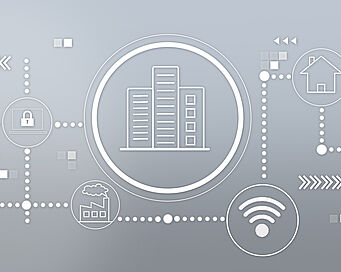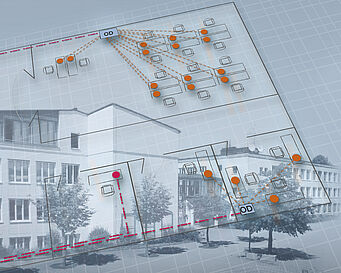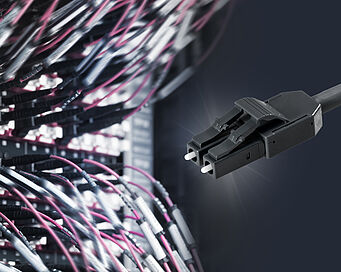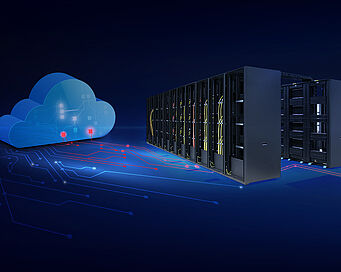IT departments are faced with an enormous challenge when it comes to building cabling, especially in up-and-coming medium-sized companies. On the one hand, strategically targeted company growth means that new workplaces have to be continuously integrated into the network. On the other hand, the ways of working together have also changed. With traditional work models, IT managers could assume that once an office is fully staffed and equipped, there will be no changes in the near future with regard to workplace allocation and connection. However, agile collaboration is the trend, especially among younger generations who are currently entering the job market. In order to increase their own attractiveness as employers, many SMEs are undergoing restructuring in this respect. Teams are being reassembled over and over again, individual offices are being transformed into "coworking spaces", and subsequently they are converted into other space solutions again. To put it in a nutshell: Modern building cabling requires flexibility in the expansion of networks as well as in room design. For this to be implemented without bandwidth bottlenecks, a number of factors must be taken into account.
Challenges in building cabling - How can a network be made flexible and scalable?
Clean Desk: Flexible Office Network
In organizations or companies where a dynamic workplace design is practiced, the so-called Clean Desk Policy is becoming increasingly popular. Desks are left at the end of the day in such a way that the space can be used by another employee the next morning. The "nine-to-five job" at a firmly established workplace is a thing of the past. Work is done in teams at a round table or at shared work islands. Once a project is finished, new teams come together. This way of working naturally has an effect on the required network architecture. For the working world 4.0 to come to life and to guarantee smooth processes, data lines, cable harnesses and connections must be provided for each computer workstation. In order to make them as flexible as possible, supply is recommended via consolidation points of an active or passive type, which can be integrated in the raised floor, on the wall or on the ceiling. If necessary, the consolidation point can be dismantled or relocated without great effort. The consolidation point is installed near the intended workstations or work islands. As a positive side effect, the use of consolidation points reduces the distances of tertiary copper cabling, which is one of the main sources of cable fires. This reduces the fire load by about two thirds and at the same time saves costs.
Network trend: "Power over Ethernet”
In order to make building cabling even more flexible and "smarter", as well as to reduce the amount of cabling, Power over Ethernet (PoE) applications are increasingly becoming a major trend in building cabling. This technology allows the electrical power supply of network-compatible devices via an existing twisted-pair Ethernet cable. As a result, the data cable not only transmits the data signals but also the electrical energy for terminal devices. The major advantage is that this eliminates the need for a separate power connection. This means in concrete terms that when workplaces are restructured in places without a power cable, there is no need to install a new power cable, which would be time-consuming. Instead, terminal devices can be connected directly to the data network. This allows modern working environments to be created quickly and flexibly within a short distance and saves time and costs in the event of a conversion. Based on specified PoE standards such as IEEE802.3af, IEEE 802.3at or IEEE 802.3bt, there are currently four types of PoE services on the market: Up to 15.4W, up to 30W, up to 60W and up to 100W. This enables the easy integration of numerous power-hungry devices into the PoE office network. This technology is particularly attractive for smart office applications. For example, PoE offers great potential for promoting the Internet of Things (IoT) and for adjusting the lighting at individual workplaces or controlling ventilation flaps depending on the level of office occupancy.
However, one important point should be borne in mind when using PoE applications. PoE generates power loss through the cable's line resistance and heat is generated. In turn, the higher cable temperatures affect the transmission of the data signals. To avert this problem, a cable temperature of 60°C must not be exceeded. One solution is to use cables with a larger copper core cross-section. For example, AWG22 cables are often recommended for installation by the industry. The major disadvantage here is higher purchase costs. An alternative and more cost-effective approach is the use of cabling systems such as those offered by Rosenberger OSI, in which the copper cabling in the tertiary area is reduced to a minimum. Due to the short transmission distances, the problem of cable heating is eliminated from the outset and the power loss occurring with PoE is significantly reduced.

Increasing data rates: Networks growing with the company
A further advantage in the use of innovative network architectures, in which the importance of the cabling media is shifted towards future-oriented fiber optic technology and the proportion of copper cabling is reduced to a necessary level, is the flexible expansion of bandwidth. In buildings where new workplaces have to be integrated into the existing network again and again, fiber optic cables are ideal because of their almost unlimited transmission capacities. Where high availability and performance are required, fiber optic cables are considered a future-proof solution. Cabling structures based on this technology are adaptable in every respect. In a dynamically growing process environment, fiber optic cables are regarded as the optimum supply infrastructure in buildings. They provide the perfect basis for the "Digital Workplace", which requires the simple connection of ever more new devices.
Network management: Solutions made easy to manage
IT departments can use the solutions mentioned above to establish a future-oriented network that is tailored to the performance requirements of the new working world 4.0 and can grow alongside flexibly as required. However, despite all the euphoria, IT experts must not ignore the administrative effort. It is important for day-to-day operations that a network is managed in a cost-effective and time-efficient manner by means of a high degree of standardization. After all, the complexity of the network should not be underestimated, especially as a result of permanent expansion or smart office solutions.
Is your building cabling already fit for the working world 4.0 and the dynamic processes associated with it?





